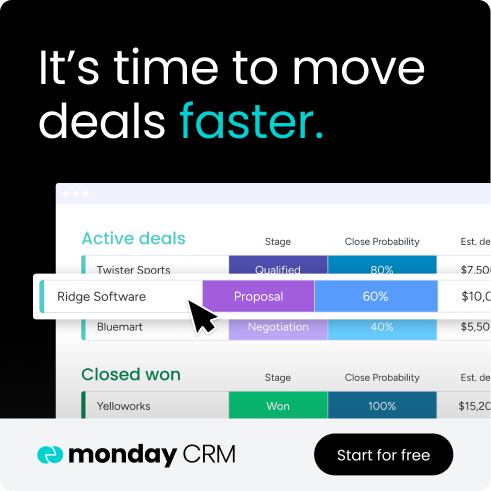A healthy sales pipeline means nothing if leads aren’t converting. Most sales teams lose deals in the gap between initial interest and signed contract: not because prospects aren’t qualified, but because manual follow-ups get missed, hot leads go cold, and reps drown in administrative work instead of selling.
Lead conversion software eliminates this chaos. A unified platform like monday CRM automates follow-ups, prioritizes your best opportunities, and keeps your team focused on closing deals instead of chasing data. This guide breaks down the top 20 platforms and shows you exactly how to choose the right one to accelerate your deal cycle.
What is lead conversion software?
Lead conversion software serves as the strategic bridge between initial prospect interest and a finalized sale. Where lead generation fills the pipeline, conversion tools provide the structured process and intelligence needed to guide potential customers through the sales journey, ensuring each interaction builds toward a successful outcome.
Managing leads across disconnected spreadsheets means your hottest prospect from yesterday’s demo gets buried under today’s inbox chaos. That follow-up email you meant to send? It’s still sitting in your drafts while your competitor just closed the deal. Your reps aren’t building relationships—they’re hunting through tabs and trying to remember which version of the lead tracker is actually current.
A robust platform provides a single source of truth, automating tedious work so your team can concentrate on what they do best. With monday CRM, you can automatically nurture leads and prioritize the most promising opportunities, giving your team the visibility and confidence required to close more deals, faster.

“There’s probably about a 70% increase in efficiency in regards to the admin tasks that were removed and automated, which is a huge win for us.“
Kyle Dorman | Department Manager - Operations, Ray White
"monday CRM helps us make sure the right people have immediate visibility into the information they need so we're not wasting time."
Luca Pope | Global Client Solutions Manager at Black Mountain
“In a couple of weeks, all of the team members were using monday CRM fully. The automations and the many integrations, make monday CRM the best CRM in the market right now.”
Nuno Godinho | CIO at VelvKey benefits of lead conversion software for revenue teams
- Eliminate manual handoffs and align your entire team: Unifying marketing and sales on a single platform removes disjointed processes and prevents valuable opportunities from slipping through the cracks, so every team member works toward one goal, accelerating the deal cycle.
- Free your reps to focus on selling, not admin work: Powerful automations handle follow-ups and nurture leads automatically, while intelligent scoring algorithms surface your most promising prospect, empowering your team to build relationships and close deals with confidence.
- Turn pipeline visibility into predictable revenue: Customizable dashboards give your entire team a clear, real-time view of progress and performance, enabling smarter decisions that consistently hit targets and eliminate guesswork from your sales strategy.
Essential features every lead conversion platform should have
An effective lead conversion platform functions as a centralized command center, consolidating critical information so every team member operates with a complete and current view of the customer. It transforms scattered data points into a cohesive and actionable strategy.
Seamless integrations and intelligent automation
Seamless connections with existing applications and automated routing of high-priority leadsfree your team to concentrate on high-impact activitiesinstead of administrative busywork. The right platform eliminates manual handoffs and ensures your best opportunities never slip through the cracks.
Flexible customization that adapts to your sales process
Your sales process is a unique competitive advantage, meaning your platform must adapt to your strategy, not force you into a rigid framework. A comprehensive view of every customer interaction, combined with simple drag-and-drop tools for building custom workflows, keeps your team agile. This flexibility empowers them to confidently guide any lead from initial contact to a closed deal.
Real-time analytics and actionable insights
A superior platform does more than present raw data—it illuminates the narrative behind the numbers, revealing what strategies are succeeding and where deals are encountering friction. Clear dashboards that translate activity into actionable insights give you the visibility and control necessary to coach your team effectively and optimize your sales funnel for better, faster decision-making.
Try monday CRMTop 20 lead conversion tools to transform your sales process
Your sales team possesses the drive to succeed; the right platform provides the fuel to convert that energy into closed deals and exceeded quotas. The sheer volume of options, however, can lead to analysis paralysis, distracting from the core mission of selling. We are here to help you cut through the noise.
Consider us your guide. We have evaluated the top 20 platforms to help you navigate the market and identify a tool that aligns with your team’s workflow, saving you countless hours of research. Our breakdown focuses on each platform’s core strength, ideal user profile, and unique value proposition, enabling you to make an informed choice that will drive meaningful results.
Are you prepared to equip your team with a tool that fosters speed, intelligence, and collaborative success? Let’s explore the platforms that deliver the visibility and automation required to build unstoppable momentum.
| Platform Name | Primary Strength | Best For | Starting Price |
|---|---|---|---|
| monday CRM | Ultimate adaptability with no-code customization | Mid-market teams needing flexible, intuitive CRM | $12/user/month |
| Salesforce | Enterprise-grade features and extensive ecosystem | Large enterprises with complex sales processes | $25/user/month |
| HubSpot CRM | All-in-one marketing and sales integration | Teams wanting unified marketing-sales workflows | Free (paid plans from $45/month) |
| Pipedrive | Visual pipeline management and deal tracking | Small to mid-size teams focused on deal progression | $14.90/user/month |
| Unbounce | A/B testing and conversion optimization | Marketing teams focused on landing page performance | $90/month |
| Leadpages | Drag-and-drop simplicity with built-in templates | Small businesses needing quick page creation | $37/month |
| Instapage | Enterprise-level personalization and analytics | Large marketing teams with complex campaigns | $199/month |
| Hotjar | User behavior insights and heatmap analysis | Teams wanting to understand visitor interactions | $32/month |
| Mixpanel | Advanced event tracking and user journey analysis | Product-led growth companies | $20/month |
| Google Analytics 4 | Comprehensive web analytics and attribution | All businesses needing traffic and conversion insights | Free |
| Mailchimp | Email marketing automation and audience segmentation | Small businesses with email-focused strategies | Free (paid from $10/month) |
| ActiveCampaign | Advanced automation and behavioral triggers | Mid-market teams needing sophisticated email workflows | $29/month |
| Intercom | Live chat and customer messaging platform | SaaS companies prioritizing real-time engagement | $74/month |
| ZoomInfo | B2B contact database and prospecting intelligence | Enterprise sales teams needing extensive lead data | Custom pricing |
| LinkedIn Sales Navigator | Social selling and professional network prospecting | B2B sales reps leveraging LinkedIn for outreach | $79.99/month |
| Outreach | Sales engagement and cadence automation | High-volume outbound sales teams | Custom pricing |
| Optimizely | Enterprise A/B testing and experimentation platform | Large companies with dedicated optimization teams | Custom pricing |
| VWO | Visual website optimization and testing | Mid-market teams wanting user-friendly testing tools | $199/month |
| GoHighLevel | White-label marketing automation for agencies | Marketing agencies managing multiple clients | $97/month |
| Keap | Small business CRM with marketing automation | Service-based businesses under 25 employees | $79/month |
1. monday CRM
monday CRM transforms lead conversion from a scattered, manual process into a streamlined, automated powerhouse that gets deals closed. The platform specializes in no-code customization and AI-powered automation, making it ideal for sales teams who want to move fast without getting bogged down in technical complexity. Built on the flexible monday.com Work OS, it adapts to any sales process while keeping your entire revenue operation connected and visible.
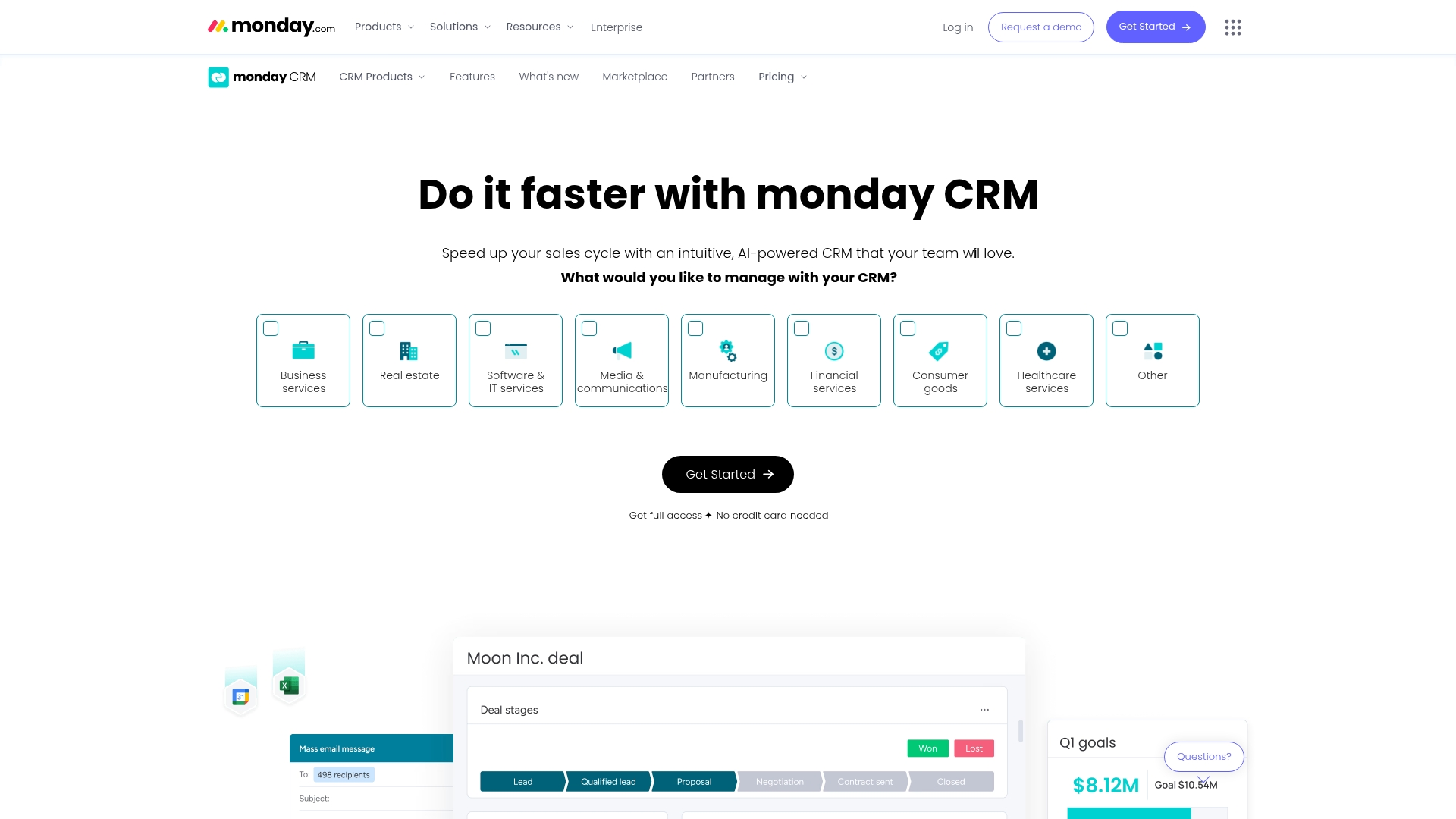
Example:
monday CRM centralizes lead management from capture to conversion, providing sales teams with automated workflows, AI-powered insights, and customizable pipelines that eliminate manual tasks and accelerate deal closure.
Key features:
- Flexible lead capture and organization: Aggregate leads from multiple sources into a unified Leads board with 15 specialized columns for comprehensive tracking and qualification.
- Intelligent automation and scoring: Pre-configured automations handle lead sorting and qualification, while formula-based lead scoring helps you prioritize prospects by considering factors like title, company size, and interest level.
- Integrated communication hub: A built-in email system with templates, AI-powered composition, and activity tracking (on Pro and Enterprise plans) keeps all prospect interactions centralized and accessible.
Pricing:
- Free: $0 for up to 2 seats (with limited features)
- Basic: $9/month per seat (billed annually)
- Standard: $12/month per seat (billed annually)
- Pro: $19/month per seat (billed annually)
- Enterprise: Custom pricing (contact sales)
- Minimum 3 users required for paid plans
- Monthly billing available at higher rates
- 18% savings with annual billing
Why it stands out:
- No-code customization: Build custom workflows and pipelines that match your exact sales process without needing IT support or technical expertise.
- Unified platform approach: Seamlessly connects sales, marketing, and operations in one Work OS, eliminating data silos and improving team alignment.
- Visual and intuitive design: Drag-and-drop interface and clean layout reduce learning curves and increase user adoption across sales teams.
Advanced AI features:
- Automated lead prioritization: The platform uses formula-based scoring to analyze data points like job titles, company size, and engagement levels, helping you automatically prioritize high-value prospects.
- Automated email composition: AI-powered email templates and content generation help sales reps craft personalized outreach messages that resonate with prospects.
- Intelligent workflow suggestions: The platform recommends automation recipes and process improvements based on your team’s activity patterns and successful conversion paths.
Automations:
- Pre-built automation recipes: Ready-to-use workflows for lead assignment, status updates, follow-up reminders, and automatic conversion from leads to contacts.
- No-code automation builder: Create custom triggers and actions without technical skills, from simple notifications to complex multi-step sequences.
- Enterprise-scale processing: Handle up to 250,000 automation actions per month on Enterprise plans, supporting high-volume sales operations.
Integrations:
- 200+ native integrations: Connect with popular tools like Gmail, Mailchimp, Slack, Facebook Ads, HubSpot, and Salesforce for seamless data flow.
- API access: Custom integrations and data synchronization capabilities for unique business requirements and existing tech stacks.
- Form and lead capture tools: Built-in WorkForms integration plus connections to external lead sources for comprehensive prospect aggregation.
Lead conversion software features:
- Duplicate detection and management: Automatically identifies duplicate leads with manual and automated merging capabilities to maintain clean, accurate prospect data (available on Standard, Pro, and Enterprise plans).
- Real-time pipeline visibility: Customizable dashboards with widgets show lead breakdown by status, role distribution, and regional analysis for instant conversion insights.
- Cross-board lead progression: Seamlessly convert qualified leads into contacts and deals, maintaining data continuity throughout the entire sales cycle.
2. HubSpot
HubSpot delivers comprehensive lead conversion software that transforms how businesses capture, nurture, and convert prospects into customers. The platform excels at unifying marketing and sales efforts through its all-in-one approach, making it perfect for companies seeking seamless lead management without juggling multiple disconnected tools.
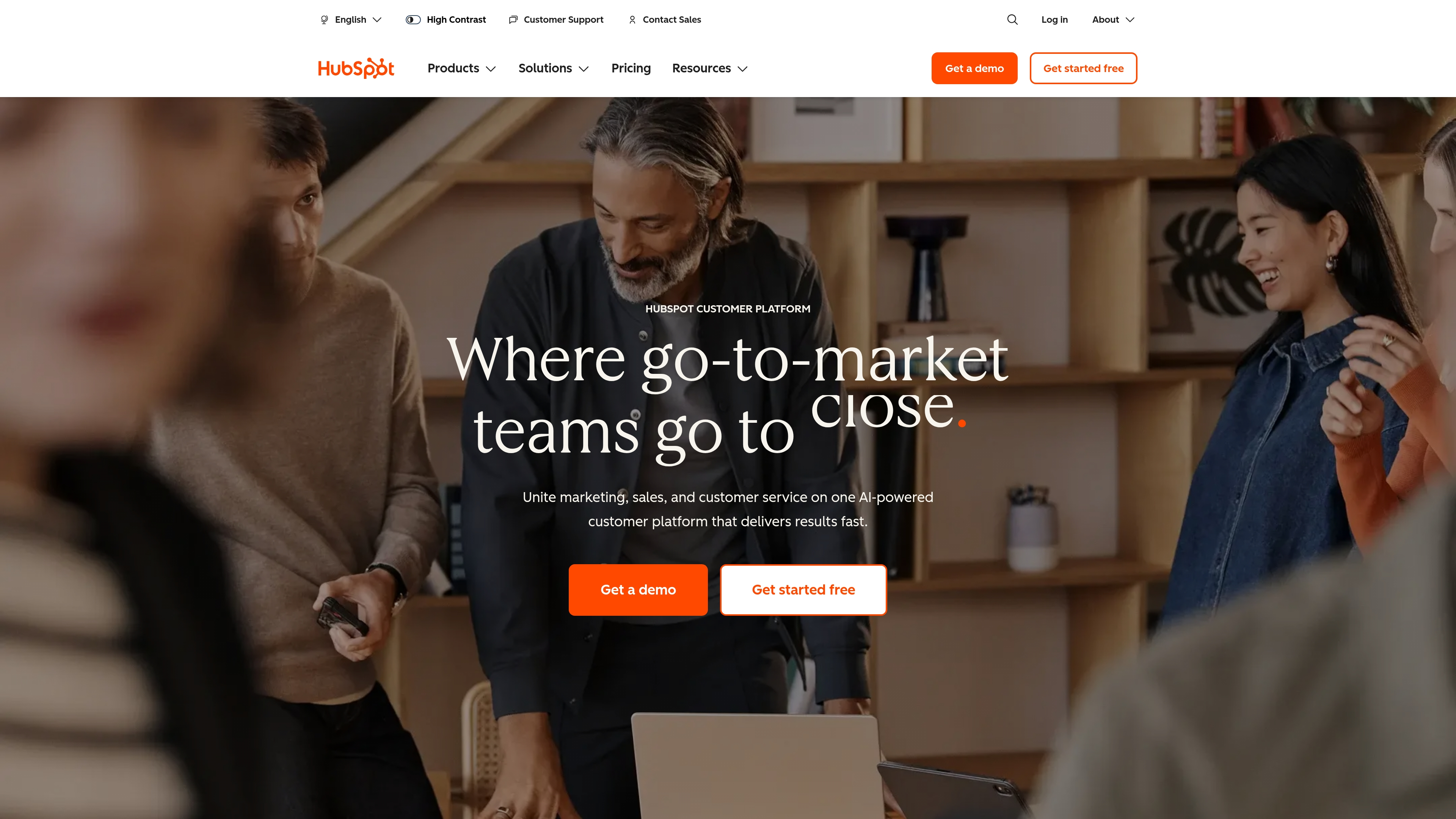
Use case:
HubSpot’s lead conversion software centralizes prospect data and automates nurturing workflows, helping sales teams prioritize high-value leads and accelerate deal closure through intelligent scoring and seamless marketing-to-sales handoffs.
Key features:
- Smart lead scoring and routing: Automatically identifies and assigns your most qualified prospects to the right sales reps based on custom criteria and AI-powered insights.
- Unified lead tracking: Consolidates all prospect interactions, from website visits to email engagement, in one centralized timeline for complete visibility.
- Automated nurturing workflows: Creates personalized email sequences and follow-up tasks that guide leads through your sales funnel without manual intervention.
Pricing:
HubSpot offers a range of plans to fit different business needs, including a free CRM to get you started. Paid plans (Starter, Professional, and Enterprise) unlock more advanced features. Since pricing can vary based on your number of contacts and specific needs, we recommend visiting HubSpot’s official website for the latest details.
Considerations:
- Pricing escalates quickly as contact lists grow and advanced features become necessary, potentially making it expensive for scaling businesses.
- The platform can become complex to manage for companies with highly specific or intricate sales processes that require extensive customization.
3. Salesforce
Salesforce delivers enterprise-grade CRM capabilities with comprehensive lead management tools designed for complex sales environments. The platform specializes in deep customization and AI-powered insights through its Einstein platform, making it ideal for large organizations with technical resources and sophisticated sales processes.
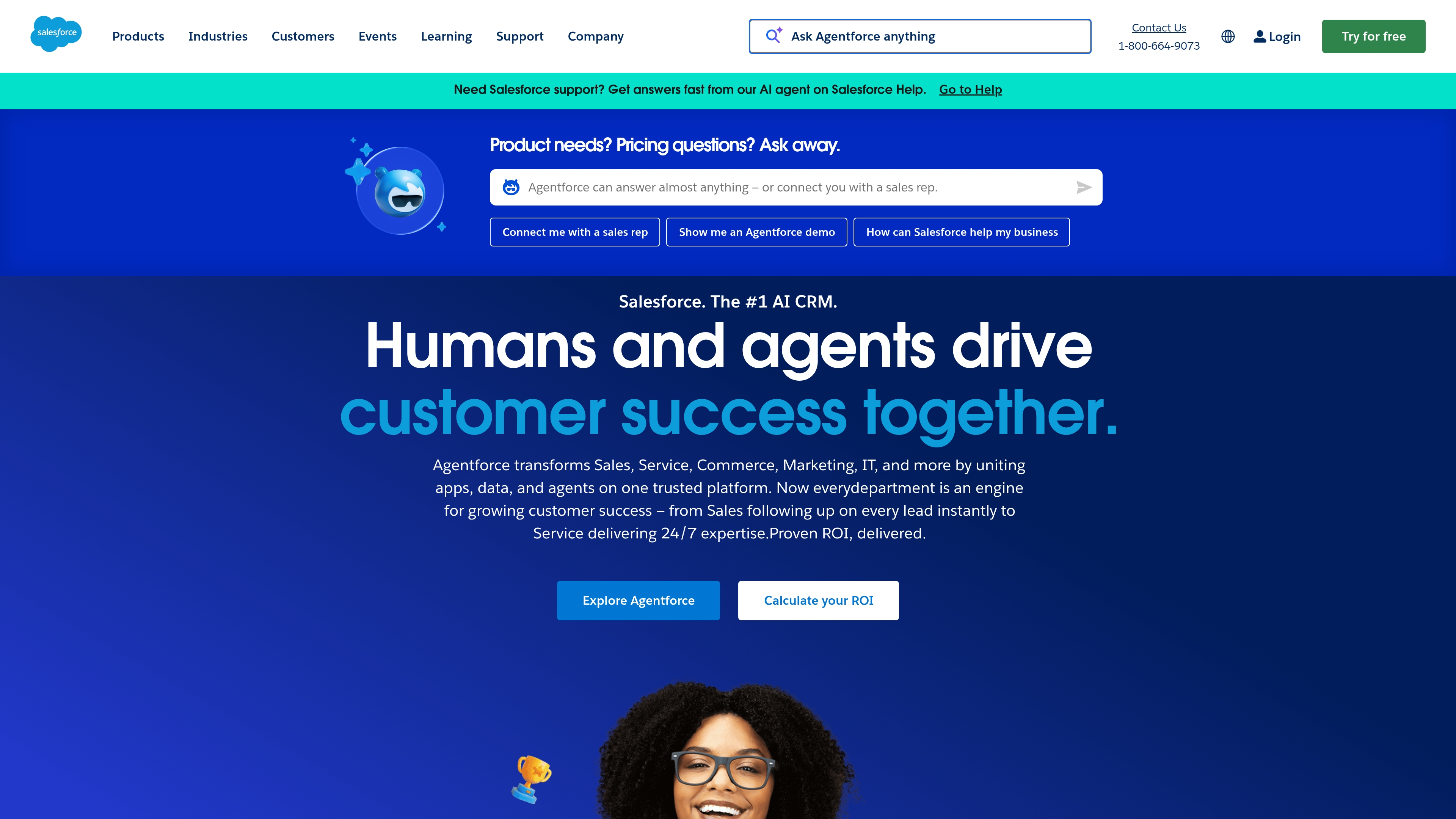
Use case:
Salesforce excels at managing high-volume lead conversion for enterprise sales teams that need advanced automation, predictive scoring, and seamless integration across marketing, sales, and service functions.
Key features:
- Einstein AI lead scoring: Automatically ranks leads based on conversion likelihood using machine learning algorithms that analyze engagement patterns and demographic data.
- Automated lead routing: Intelligently assigns leads to the right sales reps based on territory, product interest, or industry expertise through customizable assignment rules.
- Comprehensive lead nurturing: Creates personalized drip campaigns and automated follow-ups that guide prospects through complex B2B sales cycles.
Pricing:
- Pricing is tailored by product, role, and industry to fit your team’s specific needs.
- You’ll need to contact the Salesforce sales team for a personalized quote.
- A free trial is available to help you get started.
Considerations:
- Steep learning curve requires significant training investment and often necessitates hiring Salesforce specialists or consultants.
- High total cost of ownership when factoring in customization, integrations, and ongoing maintenance for complex implementations.
4. Pipedrive
Pipedrive transforms lead conversion with its visual pipeline management system, trusted by over 100,000 companies across 179 countries. Designed by salespeople for sales teams, the platform specializes in activity-based selling and intuitive deal tracking, making it a fantastic choice for small to medium-sized businesses that want to move prospects through their sales process without unnecessary complexity.
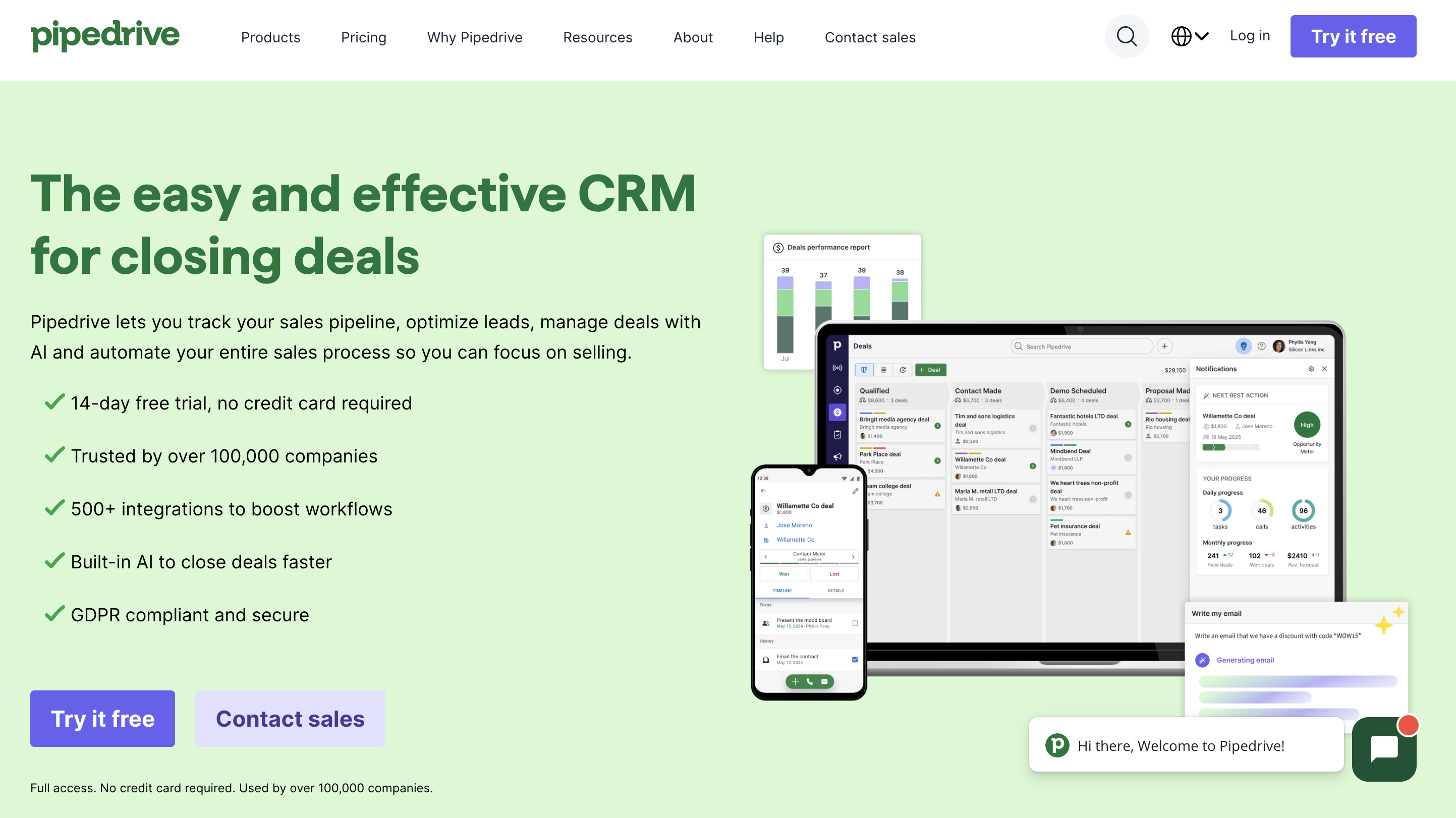 Use case:
Use case:
Pipedrive helps sales teams increase pipeline deals by an average of 93% through its visual pipeline management and dedicated Leads Inbox that separates unqualified prospects from active deals.
Key features:
- Visual pipeline management: Drag-and-drop functionality and customizable stages that match your specific sales process.
- Leads Inbox: Centralizes incoming leads before qualification, preventing pipeline clutter while enabling easy conversion to deals.
- Chatbot and Live Chat: Tools to engage website visitors and capture leads in real time.
- AI-powered sales tools (Beta): Helps rank leads, suggest next actions, and automate prospect qualification.
Pricing:
- Lite: $14/user/month
- Growth: $39/user/month
- Premium: $59/user/month
- Ultimate: $79/user/month
- Add-ons: Enhance your plan with tools like Projects or LeadBooster, starting at $6.67/month per company.
Considerations:
- Reporting capabilities may be too basic for teams requiring detailed analytical insights and advanced data visualization.
- Marketing features are limited, often requiring integration with specialized tools for comprehensive lead nurturing campaigns.
5. Zoho CRM
Zoho CRM delivers comprehensive lead conversion capabilities within an affordable, all-in-one business platform. The solution stands out for small to medium-sized businesses seeking cost-effective CRM functionality without sacrificing powerful features like AI-powered lead scoring and multi-channel nurturing.
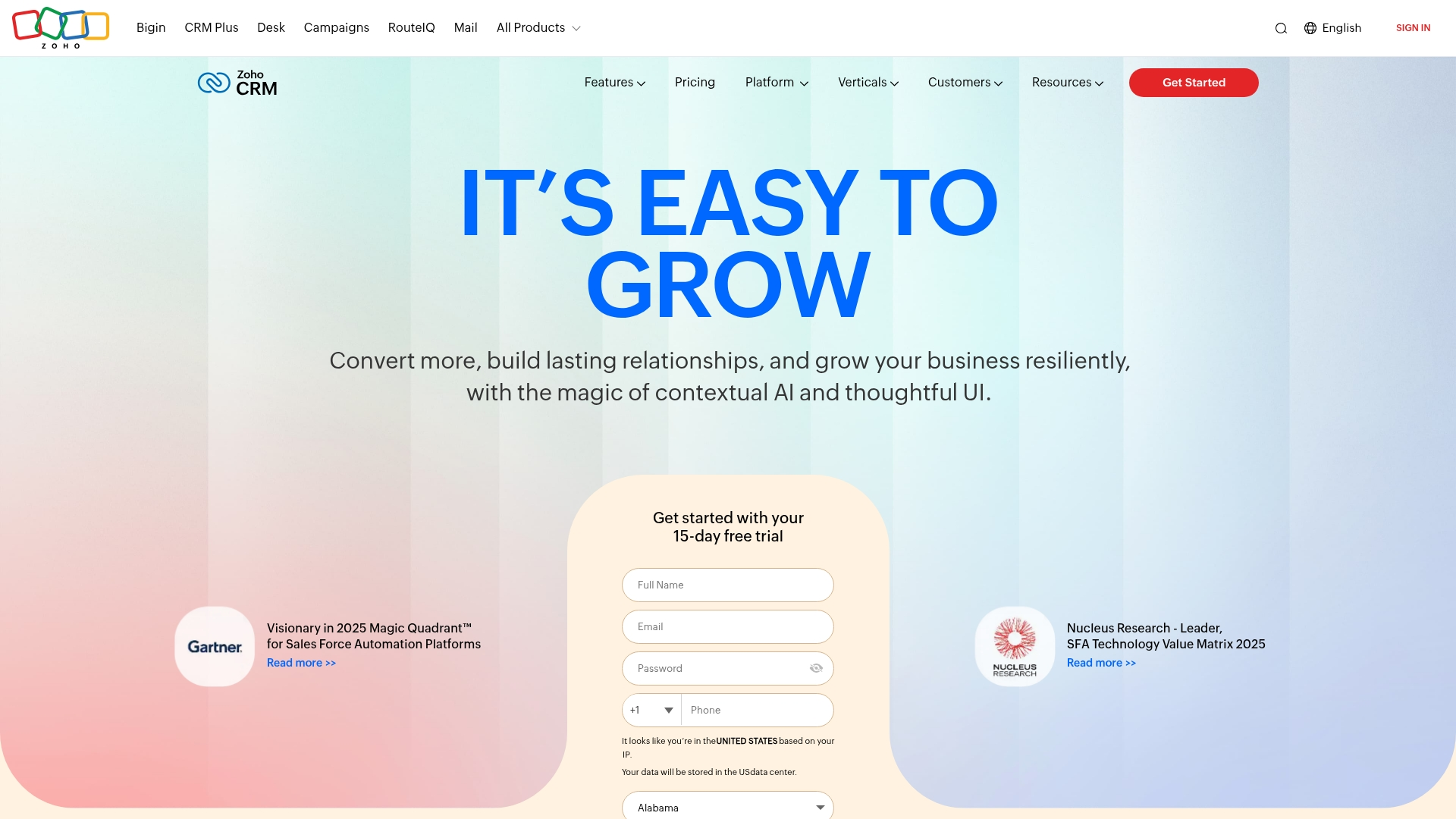
Use case:
Zoho CRM excels at helping businesses capture leads from multiple channels, enrich prospect data with AI assistance, and nurture relationships through automated sequences, all while maintaining strict privacy compliance.
Key features:
- Multi-channel lead capture from websites, social media, and live chat with automatic data enrichment
- AI-powered lead scoring through Zia assistant to prioritize high-conversion prospects
- Omni-channel communication across email, phone, WhatsApp, and social platforms with automated follow-up sequences
Pricing:
- Free: $0/month for up to 3 users with basic lead management and mobile apps
- Standard: $14/user/month (billed annually) or $20/user/month (billed monthly)
- Professional: $23/user/month (billed annually) or $35/user/month (billed monthly)
- Enterprise: $40/user/month (billed annually) or $50/user/month (billed monthly)
- Ultimate: $52/user/month (billed annually) or $65/user/month (billed monthly)
- Team User Add-on: $9/team user/month for non-sales users with limited CRM access
- All plans include a free trial with no credit card required
Considerations:
- Free version has significant limitations including no lead assignment queues and restricted customization options
- Some users report the interface can feel clunky and require multiple steps for simple tasks
How AI enhances lead conversion in modern sales teams
Your team has plenty of leads – but the real challenge is knowing which ones will actually convert. AI transforms that chaotic influx into a refined system that surfaces your best opportunities and lets reps focus on high-potential conversations instead of guesswork.
monday CRM’s AI tools act as an intelligent assistant for every rep, automating busywork and instantly flagging your most promising leads. Your team spends less time on data entry and more time building relationships and closing deals.
The result? A sales process that’s proactive instead of reactive. With AI handling lead scoring and routing, the right rep connects with the right prospect at exactly the right moment, accelerating your entire sales cycle and helping your team win more deals.
AI-powered lead conversion delivers:
- Automatic lead scoring that prioritizes your highest-value prospects
- Intelligent routing that matches leads to the best-fit sales rep
- Predictive insights that reveal which deals are most likely to close
Choosing the right lead conversion software for your business
The right lead conversion software isn’t about collecting the most features. It’s about finding a system that powers your entire revenue operation. The ideal platform connects every customer touchpoint, ensuring no opportunity slips through the cracks while building a foundation for scalable growth.
Your goal is to cut through the market noise and focus on what actually empowers your sales team. A simple evaluation framework helps you identify a solution that enables faster execution, confident closing, and perfect team alignment. The key is matching your unique sales process to a platform that feels custom-built for your needs.
Assess your current sales process
Start by analyzing your existing sales methodology. Map the complete customer journey from initial lead to closed deal, pinpointing where communication breaks down or manual tasks create bottlenecks. Understanding your average sales cycle length and common obstacles establishes a clear baseline for improvement.
Consider your team structure: whether you’re managing a small, agile squad or a large, distributed sales force. monday CRM flexes to fit any sales cycle, but understanding your specific workflows is crucial for optimal configuration from day one.
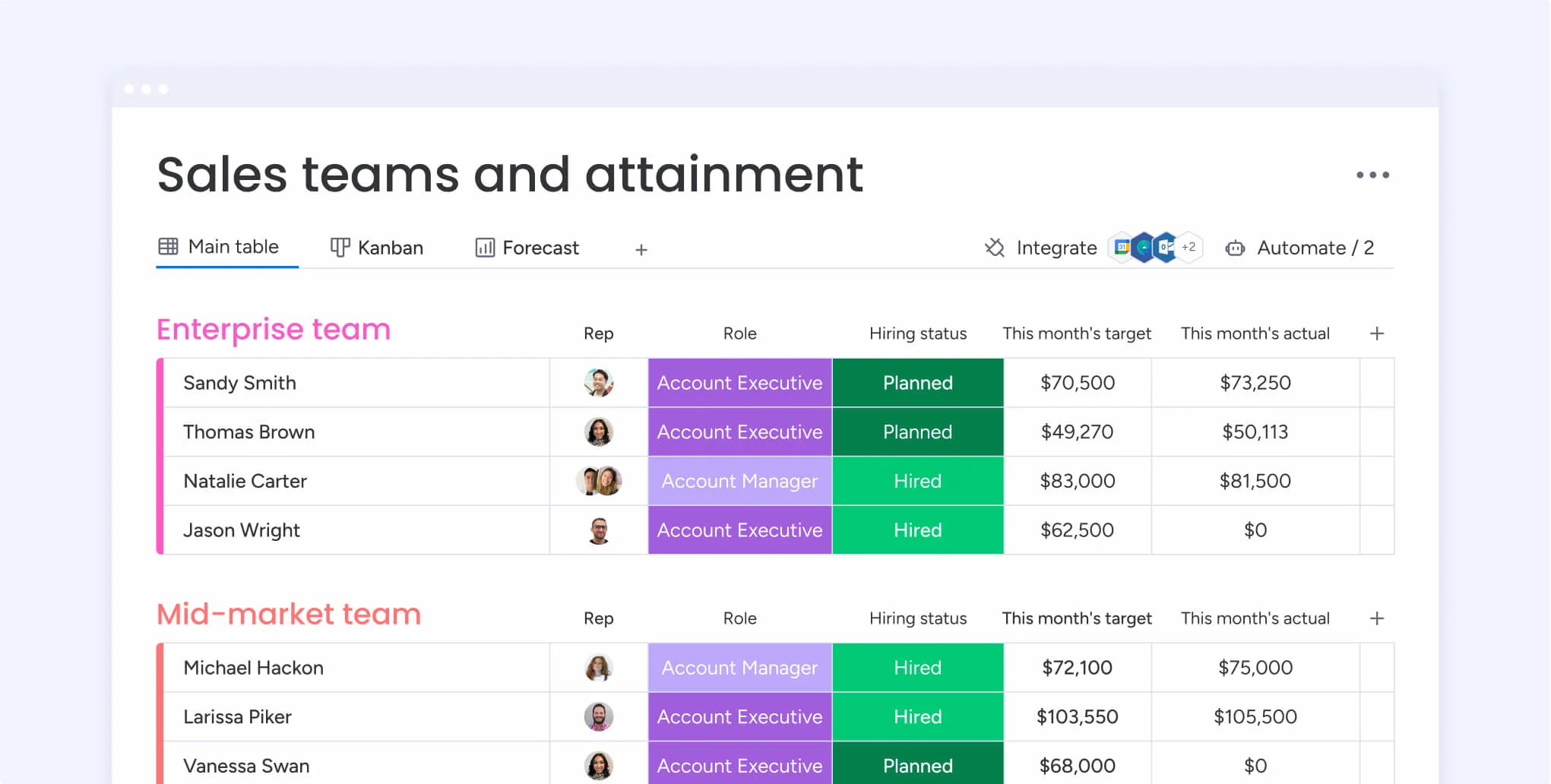
The goal isn’t to overhaul your process, but to amplify its strengths and eliminate its weaknesses.
Evaluate integration requirements
Your CRM should be a central hub, not an isolated data island. Take inventory of the essential tools your team uses daily, from email marketing platforms to customer support systems. True operational efficiency happens when data flows seamlessly between applications, creating a single source of truth for your entire organization.
Prioritize platforms offering robust connectivity through native integrations and flexible APIs. monday CRM connects your existing tech stack without technical hurdles, ensuring every customer interaction is captured and contextualized in one place. This complete view gives your team the full picture needed for smarter, faster decisions.
Consider team size and scalability
Your organization is built for growth, and your CRM needs to scale alongside it. Look at your strategic roadmap for the coming years. Will your chosen software support that trajectory, or become a limiting factor? The right platform is an investment that champions your growth, not one you’ll quickly outgrow.
monday CRM adapts as you expand your team, data volume, and workflow complexity. It evolves with your business, allowing easy customization of permissions and dashboards without disruptive migrations. This is a long-term partnership in your company’s success.
Calculate ROI and budget
CRM ROI extends far beyond the subscription price. The true value is measured in time returned to your team: time reinvested in building relationships and closing deals instead of managing spreadsheets. Calculate the tangible impact of automating follow-ups, streamlining data entry, and gaining clear pipeline visibility.
An effective CRM pays for itself through increased efficiency and higher win rates. With monday CRM, you’re not just buying software. You’re investing in a faster, more confident sales team and a system designed to fuel revenue growth. That return shows up on your balance sheet and in your team’s morale.
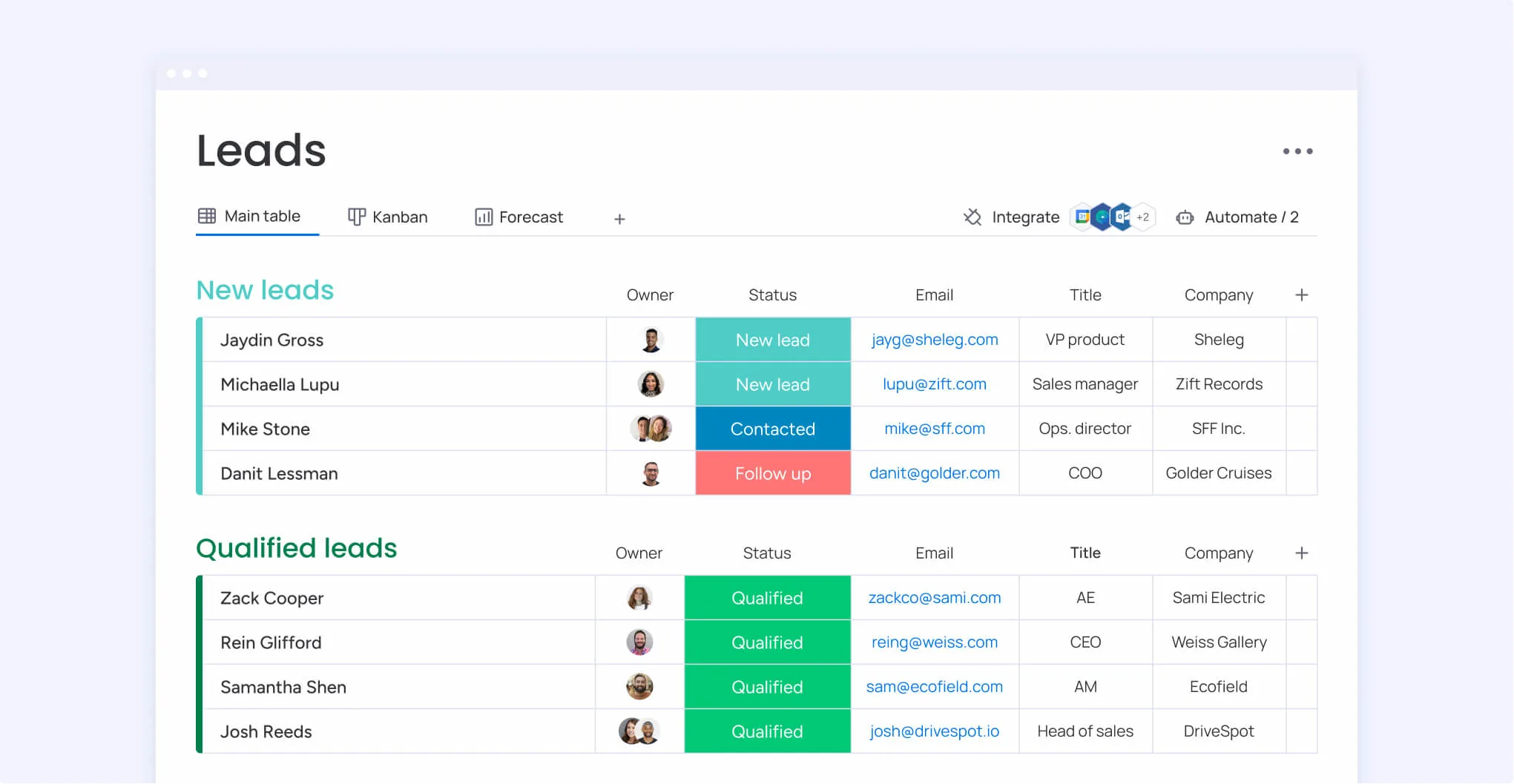
Why monday CRM stands out for lead conversion
The ultimate goal is to convert leads into lasting customer relationships, yet many CRMs hinder this process with inflexible structures and administrative overhead. monday CRM was engineered to remove these obstacles, offering a dynamic and intelligent platform that accelerates sales cycles and empowers teams to build meaningful connections and close deals with greater confidence.
No-code customization for any sales process
Your team has a proven sales methodology, and your CRM should enhance it, not constrain it. With our no-code, drag-and-drop builder, you can configure pipelines that precisely match your sales process, allowing for rapid adaptation without requiring technical support.
When the tool perfectly mirrors the workflow, your reps can build and maintain incredible momentum, spending less time on data entry and more time engaged in the strategic conversations that drive revenue.
AI blocks for automated lead intelligence
Our AI blocks automatically score leads, analyze email sentiment, and recommend the next best action, transforming raw data into a clear, actionable roadmap for your reps.
This capability allows your team to concentrate its energy where it will have the greatest impact, confidently engaging high-priority prospects while the system nurtures the rest, functioning as a 24/7 strategy assistant for every member of your sales team.
Unified platform for complete customer journey
A closed deal marks the beginning of the customer relationship, making a smooth handoff to post-sales teams essential for long-term success. Because monday CRM is an integral part of a unified Work OS, the entire customer journey (from the first marketing touchpoint to final project delivery) is managed within one connected environment.
This unified structure fosters seamless collaboration between sales, account management, and customer success teams, giving everyone the necessary context to deliver the consistent, high-quality experience that modern customers expect.
Ready to transform your sales process? Try monday CRM
FAQ
How long does lead conversion software take to implement?
The time it takes to implement lead conversion software varies. Basic implementation takes 1–2 weeks, while more complex setups can take up to a month. Intuitive, no-code platforms significantly shorten this timeline by empowering your team to build their own workflows without IT support.
What ROI can businesses expect from lead conversion software?
The primary ROI comes from automating manual tasks, which frees up your sales team to focus on selling and closing deals faster. Most teams see a positive return within the first quarter from increased efficiency alone.
Can lead conversion software integrate with existing CRM systems?
Yes, modern platforms are built to integrate with existing systems using both native connections for popular tools and flexible APIs for custom workflows.
How much does lead conversion software typically cost?
Pricing typically ranges from $10–$100+ per user per month, depending on the plan's features and capabilities. The best value comes from software that reduces administrative work and helps close deals, not just the lowest subscription price.
What is the difference between lead generation and lead conversion software?
The difference between lead generation and lead conversion software is their primary function. Lead generation tools focus on attracting and capturing new prospects. Lead conversion software takes over from there, providing the framework to nurture relationships and guide those prospects toward a sale.
Do small businesses need lead conversion software?
Yes, small businesses benefit significantly once manual tracking in spreadsheets becomes inefficient, typically after managing more than 20–30 leads per month. It prevents dropped leads and ensures consistent follow-up.
 Get started
Get started 

